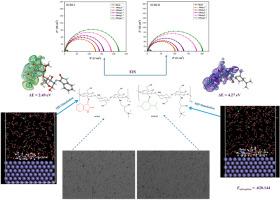壳聚糖希夫碱衍生物作为Q235碳钢的环保型缓蚀剂的实验与理论结合研究
IF 4.9
3区 材料科学
Q2 CHEMISTRY, MULTIDISCIPLINARY
引用次数: 0
摘要
本研究以壳聚糖为原料,分别通过壳聚糖与isatin和menthone的缩合反应合成了两种新型的Schiff碱SCBS-I和SCBS-II。通过2,3-环氧丙基三甲基氯化铵(EPTAC)进一步季铵化制备的希夫碱,以提高抑制剂的溶解度和抑制效率。是一种绿色环保的Q235碳钢在盐酸溶液中的缓蚀剂。通过1H NMR和FTIR对两种壳聚糖衍生物的成功合成进行了表征。通过减重来评估抑制剂的效率,在250 mg时达到了94.8%的抑制效率。L−1。电化学研究包括EIS和PDP测量表明,抑制剂是混合类型,同时符合Langmuir吸附等温线模型。吉布斯自由能(ΔG)表明,抑制剂通过物理和化学吸附作用吸附在碳钢表面。利用扫描电镜(SEM)和XPS对金属表面形貌进行了研究,证实金属表面形成了一层吸附保护膜。采用分子动力学模拟方法研究了其缓蚀机理。这些发现为设计环保的希夫基壳聚糖衍生物提供了新的见解,未来的工作将集中在优化分子结构和评估其在更复杂腐蚀环境中的性能上。本文章由计算机程序翻译,如有差异,请以英文原文为准。

A novel chitosan Schiff base derivatives as eco-friendly corrosion inhibitors for Q235 carbon Steel: A combined experimental and theoretical study
In this study, two novel chitosan-based Schiff bases, SCBS-I and SCBS-II, were synthesized by condensation reactions between chitosan and isatin or menthone, respectively. The prepared Schiff bases were further quaternized via 2,3-epoxypropyltrimethylammonium chloride (EPTAC) to augment inhibitor solubility and inhibition efficiency. Developed as a green and eco-friendly corrosion inhibitor for Q235 carbon steel in hydrochloric solution. The successful synthesis of two chitosan derivatives was characterized via 1H NMR and FTIR studies. The inhibitors efficiency was evaluated through weight loss, with a greater inhibition efficiency of 94.8 % achieved at 250 mg. L−1. Electrochemical studies including EIS and PDP measurements suggest the inhibitors act as mixed types, while aligning with the Langmuir adsorption isotherms model. Gibbs free energies (ΔG) indicate that the inhibitors adsorb onto the carbon steel surface via physical and chemical adsorptions. The surface morphology was investigated using SEM, and XPS confirmed the formation of an adsorbed protective film on the metal surface. Molecular dynamics simulations were applied to investigate the corrosion inhibition mechanism. These findings provide new insights into the design of eco-friendly Schiff base–chitosan derivatives, and future work will focus on optimizing molecular structures and evaluating their performance in more complex corrosive environments.
求助全文
通过发布文献求助,成功后即可免费获取论文全文。
去求助
来源期刊
CiteScore
7.80
自引率
2.50%
发文量
605
审稿时长
40 days
期刊介绍:
The Journal of Physics and Chemistry of Solids is a well-established international medium for publication of archival research in condensed matter and materials sciences. Areas of interest broadly include experimental and theoretical research on electronic, magnetic, spectroscopic and structural properties as well as the statistical mechanics and thermodynamics of materials. The focus is on gaining physical and chemical insight into the properties and potential applications of condensed matter systems.
Within the broad scope of the journal, beyond regular contributions, the editors have identified submissions in the following areas of physics and chemistry of solids to be of special current interest to the journal:
Low-dimensional systems
Exotic states of quantum electron matter including topological phases
Energy conversion and storage
Interfaces, nanoparticles and catalysts.

 求助内容:
求助内容: 应助结果提醒方式:
应助结果提醒方式:


